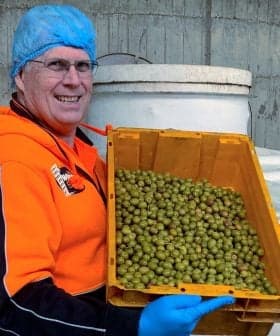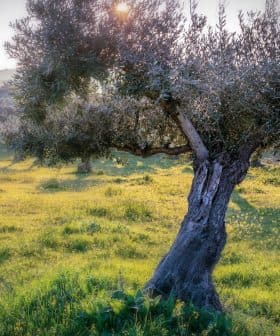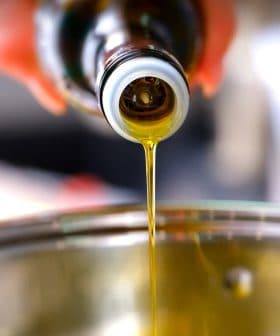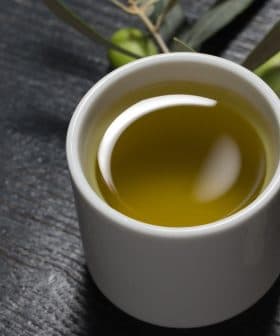Most Extra Virgin Olive Oils Score Well in New Test for Phenolic Compounds
Prokopios Magiatis and Eleni Melliou from the University of Athens conducted a study in California to measure phenolic compounds in extra virgin olive oil using NMR, with results presented at the FOODMR2014 conference. The study found that 56 out of 110 store-bought EVOOs had an excellent phenolic profile, with a potential for almost half of those to qualify for the EU labeling health claim.
Back in October, 2013 Prokopios Magiatis and Eleni Melliou from the University of Athens could be seen in stores around Northern California stocking up on dozens of bottles ofextra virgin olive oil as part of a privately-funded research project to measure phenolic compounds using NMR (Nuclear Magnetic Resonance) and to determine how many of the store-bought EVOOs would qualify for the EU labeling regulation 432/2012.
The test results were presented at the FOODMR2014 conference in Cesena, Italy last week which focused on applications of magnetic resonance, especially NMR in the study of foods. More than 200 participants presented new applications.
During the conference, Magiatis presented a new version of the recently-reported NMR method that can quickly measure phenolic compounds that support the EU 432/2012 health claim that 5mg per day of hydroxytyrosol and derivatives (oleuropein complex and tyrosol) offer protection against LDL oxidation: “Olive oil polyphenols contribute to the protection of blood lipids from oxidative stress.”
Oleocanthal and oleacein are the two most abundant forms of conjugated hydroxytyrosol and tyrosol in most olive oils, together with oleuropein aglycon and ligstroside aglycon.
The samples the team collected in California were tested by the UC Davis Olive Center for oleocanthal, oleacein, oleuropein aglycon and ligstroside aglycon. The study was performed by Prokopios Magiatis, Eleni Melliou and Brian Killday.
“Our target was to develop a reliable method to measure all the compounds mentioned in the regulation in one experiment and provide the necessary data for the health claims,” Dr. Magiatis said.
The good news is that 56 out of 110 of the EVOOs bought at supermarkets and local stores had an excellent phenolic profile, according to the results and almost half of those would qualify for the EU labeling health claim.
The EU is in the process of deciding whether the measurement of oleocanthal can be included in the necessary total to make the new claim. Dr. Maria-Isabel Covas who conducted the EUROLIVE human trials that formed the basis of EU 432/2012 has categorically stated that oleocanthal should be measured and included, and other scientists interviewed have agreed.
If oleocanthal were included, half of the EVOOs tested in California would qualify to make the claim. If it is finally decided that oleocanthal should not be measured, then fewer than 1 in 5 would qualify.
Magiatis went on to explain: “It is not only the brand that plays a role but also the variety, and the type of olive mill is a critical point. The total polyphenols content is not so characteristic if we don’t know which exactly is the dominating one.

“For example, the Mission variety from California presented in all analyzed samples significantly higher (5 times more) concentration of oleuropein aglycon than all Mediterranean varieties. Characteristically the Berkeley Olive Grove Mission showed the highest concentration among all studied samples at 397 mg/kg. In fact, all California oils containing Mission oil, even within a blend, were found to be very rich. This specific phenolic compound has been related to activity against Alzheimer’s disease.”
“Another important factor is the type of mill used. Apollo Olive Oil, also from Northern California, contained the most phenolic compounds in total. This could be attributed to the vacuum-sealed olive mill they are using.”
Invented by the late Marco Mugelli, the internationally recognized agricultural scientist, engineer and olive oil expert, the vacuum mill can achieve higher polyphenol levels by extending the malaxation period without increasing oxidation.
The EVOOs tested with the highest amounts of each phenolic compound were:
oleuropein aglycon — 397.2 — Berkeley Olive Grove 1913 — California
oleacein — 400.6 — Apollo Sierra Organic — California
ligstroside aglycon — 174.5 — Lucini — Italy
oleocanthal — 403.2 — Colavita — Italy
An organoleptic analysis is also being conducted on all of the EVOOs. Magiatis said he will present the NMR data in conjunction with an organoleptic analysis in the near future. Perhaps this could lead to a new class of EVOOs combining the best of both worlds, giving additional meaning to the phrase, “taste test.”
Magiatis went on to say: “One of the most important aspects of our research in measuring phenolic content ofextra virgin olive oil using NMR is that we discovered that the HPLC method does not measure the individual phenolic compounds very accurately. This problem is caused by the solvents used to extract and analyze the phenols from the olive oil. How can we implement a regulation that demands the precise measurement of individual phenolic compounds using a method that is proven inaccurate?”
The test results should not be seen as a guarantee the specific brands will contain the same amounts when bought in a different time or place. Some phenolic compounds tend to maintain themselves over time better than others. Many factors affect the phenolic levels, including the type of mill, time of harvest and bottling, the type of bottle used, the amount of time spent on the shelf, and conditions in the warehouse or in transport. The brand names that failed the test will not be published but many of them were very close to qualifying. A strict cut-off point for phenolic content was used, based on the EU regulation 432/2012 of 250 mg per kilogram.
It should also be noted the NMR method has been verified as a valid research tool and peer-reviewed. The NMR method of measurement was invented in Greece but has not been submitted for acceptance by the IOC (International Olive Council). An inquiry was made to the ministry responsible as to why it has not been submitted for official recognition to the IOC or the EU. As of the date of publication, there has been no response. One well-placed source in the ministry who wished to remain anonymous did admit the issue is “political”.
The 56 store-boughtextra virgin olive oil brands that showed high phenolic totals and their test results can be found here.









